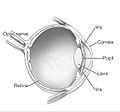Corneal neovascularization

Editor-In-Chief: Prab R Tumpati, MD
Obesity, Sleep & Internal medicine
Founder, WikiMD Wellnesspedia &
W8MD medical weight loss NYC and sleep center NYC
| Corneal neovascularization | |
|---|---|
 | |
| Synonyms | N/A |
| Pronounce | N/A |
| Specialty | N/A |
| Symptoms | Red eye, decreased vision, photophobia |
| Complications | Corneal scarring, vision loss |
| Onset | Gradual |
| Duration | Chronic |
| Types | N/A |
| Causes | Contact lens overwear, corneal infection, trauma, hypoxia |
| Risks | Contact lens use, eye surgery, chemical injury |
| Diagnosis | Slit lamp examination, fluorescein angiography |
| Differential diagnosis | Conjunctivitis, keratitis, pterygium |
| Prevention | Proper contact lens hygiene, avoiding eye trauma |
| Treatment | Topical corticosteroids, anti-VEGF therapy, surgical intervention |
| Medication | N/A |
| Prognosis | Variable, depending on severity and treatment |
| Frequency | Common in contact lens users |
| Deaths | N/A |
Corneal Neovascularization is a pathological condition characterized by the growth of new blood vessels into the cornea, which is normally avascular. This condition can significantly compromise visual acuity and ocular health, leading to a range of visual impairments. The cornea's transparency is crucial for the refraction of light onto the retina, and the invasion of blood vessels disrupts this clarity, potentially resulting in visual disturbances or blindness.
Causes[edit]
Corneal neovascularization can be triggered by a variety of factors, including but not limited to:
- Ocular surface disease and inflammation
- Contact lens overwear or misuse
- Chemical burns to the eye
- Infectious keratitis, involving bacterial, viral, fungal, or parasitic infections
- Corneal hypoxia, or reduced oxygen supply to the cornea
- Dry eye syndrome
- Corneal graft rejection
Symptoms[edit]
Symptoms of corneal neovascularization may include:
- Redness of the eye
- Sensitivity to light (Photophobia)
- Blurred vision
- Pain or discomfort in the eye
- The feeling of a foreign body in the eye
Diagnosis[edit]
Diagnosis of corneal neovascularization involves a comprehensive eye examination, including:
- Visual acuity test
- Slit lamp examination to observe the extent and pattern of neovascularization
- Corneal topography or OCT (Optical Coherence Tomography) scans to assess the cornea's shape and thickness
- Fluorescein angiography to highlight the blood vessels
Treatment[edit]
Treatment aims to reduce the risk factors, control the underlying cause, and inhibit the growth of new blood vessels. Options include:
- Anti-VEGF therapy (Vascular Endothelial Growth Factor inhibitors), such as bevacizumab or ranibizumab, to directly target the growth of new blood vessels
- Corticosteroids to reduce inflammation
- Laser photocoagulation to cauterize and close off the vessels
- Photodynamic therapy with verteporfin
- Surgical options, such as fine needle diathermy or corneal transplantation in severe cases
Prevention[edit]
Preventive measures focus on minimizing the risk factors associated with corneal neovascularization:
- Proper use and care of contact lenses
- Timely treatment of corneal infections and injuries
- Protecting eyes from chemical exposures and UV light
- Managing dry eye syndrome and other ocular surface diseases
Prognosis[edit]
The prognosis for individuals with corneal neovascularization varies depending on the cause, extent, and response to treatment. Early detection and treatment are crucial for preserving vision and preventing permanent damage to the cornea.
Gallery[edit]
-
Sagittal view of the human eye
-
Normal cornea
Ad. Transform your life with W8MD's Budget GLP-1 injections from $75


W8MD offers a medical weight loss program to lose weight in Philadelphia. Our physician-supervised medical weight loss provides:
- Weight loss injections in NYC (generic and brand names):
- Zepbound / Mounjaro, Wegovy / Ozempic, Saxenda
- Most insurances accepted or discounted self-pay rates. We will obtain insurance prior authorizations if needed.
- Generic GLP1 weight loss injections from $75 for the starting dose.
- Also offer prescription weight loss medications including Phentermine, Qsymia, Diethylpropion, Contrave etc.
NYC weight loss doctor appointmentsNYC weight loss doctor appointments
Start your NYC weight loss journey today at our NYC medical weight loss and Philadelphia medical weight loss clinics.
- Call 718-946-5500 to lose weight in NYC or for medical weight loss in Philadelphia 215-676-2334.
- Tags:NYC medical weight loss, Philadelphia lose weight Zepbound NYC, Budget GLP1 weight loss injections, Wegovy Philadelphia, Wegovy NYC, Philadelphia medical weight loss, Brookly weight loss and Wegovy NYC
|
WikiMD's Wellness Encyclopedia |
| Let Food Be Thy Medicine Medicine Thy Food - Hippocrates |
Medical Disclaimer: WikiMD is not a substitute for professional medical advice. The information on WikiMD is provided as an information resource only, may be incorrect, outdated or misleading, and is not to be used or relied on for any diagnostic or treatment purposes. Please consult your health care provider before making any healthcare decisions or for guidance about a specific medical condition. WikiMD expressly disclaims responsibility, and shall have no liability, for any damages, loss, injury, or liability whatsoever suffered as a result of your reliance on the information contained in this site. By visiting this site you agree to the foregoing terms and conditions, which may from time to time be changed or supplemented by WikiMD. If you do not agree to the foregoing terms and conditions, you should not enter or use this site. See full disclaimer.
Credits:Most images are courtesy of Wikimedia commons, and templates, categories Wikipedia, licensed under CC BY SA or similar.
Translate this page: - East Asian
中文,
日本,
한국어,
South Asian
हिन्दी,
தமிழ்,
తెలుగు,
Urdu,
ಕನ್ನಡ,
Southeast Asian
Indonesian,
Vietnamese,
Thai,
မြန်မာဘာသာ,
বাংলা
European
español,
Deutsch,
français,
Greek,
português do Brasil,
polski,
română,
русский,
Nederlands,
norsk,
svenska,
suomi,
Italian
Middle Eastern & African
عربى,
Turkish,
Persian,
Hebrew,
Afrikaans,
isiZulu,
Kiswahili,
Other
Bulgarian,
Hungarian,
Czech,
Swedish,
മലയാളം,
मराठी,
ਪੰਜਾਬੀ,
ગુજરાતી,
Portuguese,
Ukrainian

